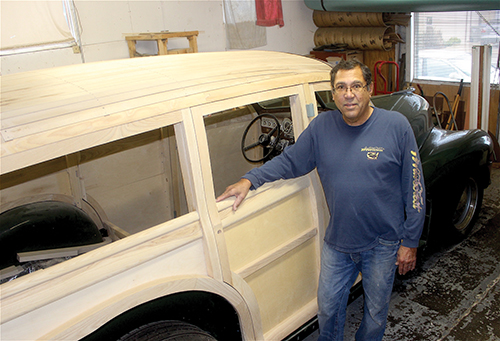David Henderson of David Henderson’s Classic Woodworks shop poses with a 1948 Chevy Fleetmaster wagon that he’s been rebuilding for over 2 years now in his little custom woodworking shop in Morro Bay. Photo by Neil Farrell
Woody wagons and other antique automobiles hold a special place in the hearts of all classic car lovers and it makes sense that such special vehicles require the skills of a very special kind of craftsman.
On a quiet side street in Downtown Morro Bay, in a historic building, sits David Henderson’s Classic Woodworks, the workshop of master craftsman, David Henderson, whose specialty woodworking focuses on restoring, and rebuilding classic Woody wagons, as well as classic wooden boats.
Chances are when you see a Woody wagon at one of the local car shows, Henderson just might have been the one who brought it back to life, that’s how many of these unique cars he’s worked on since opening the shop in 1999.
And it’s a craft he’s honed over a lifetime. “My dad was a boat builder,” he explains, taking a break from working in the shop, which has the down-home aroma of sawdust (he laughs that is smells like “burnt wood”).
Historically, Woody station wagons were manufactured by Ford, Chevy and Mercury from about 1928-1951. The bodies of the early models were constructed entirely out of wood, he explains opening the solid wooden door of a 1948 Chevy Fleetmaster, whose entire back half of the body is wood. He compares it to another 1950s wagon, also in the shop, that has steel doors with wood attached to the outside.
They did this for strength, he explains.
He’s been working on the ‘48 Fleetmaster for over 2 years. When it came in, it didn’t have the wooden portion of the body and Henderson said he had a heck of a time rebuilding it from scratch. Since that time it’s been a labor of love, literally recreating the vehicle’s original body, piece by agonizing piece.
But patience is something he’s got loads of. Doing this kind of specialty carpentry work is nothing if not detailed. Each piece is created individually and then pieced together to make it all fit together almost seamlessly.
That involves a lot of cutting, shaping, planning and sanding, lots and lots of sanding. Indeed, sanding is the one thing he says is the worst aspect of his craft.
He started working with his dad at Driskoll’s Marine down in San Diego, where he hails from. Jerry Driskoll, who started the business down south, moved to Morro Bay upon retirement and took over the old Fishermen’s Dock and former processing plant.
Driskoll revitalized the docks, rebuilt the wharf and transformed the processing plant into a takeout fish & chips and fish market that’s been carried on by Dockside, Too.
“That’s where I started,” Henderson says. “We built some awfully nice sailboats.”
He says the boat building industry has changed over the years and they started building bigger and bigger boats and then motor yachts, working with exotic woods like teak.
“I spent a lot of years working with my father,” he says. When dad retired, people started bringing him Woody wagons and boats to work on and he helped his dad on those side jobs as well, learning all the tricks of the trade. “My skill set lends itself to it,” he says.
In 1999, he and wife Lisa were ready to leave San Diego and look for a simpler life. They were living in a motorhome and took off in search of a new home. They landed in Morro Bay and fell in love with the place. “We had been living in a motorhome and traveled for a year hitting different spots looking for where we wanted to land.
“My wife was determined” to move up here, he laughs. They discovered an empty former auto shop owned by Howard Caccia and rented it for his new workshop. “We had the space rented before we moved up here.”
For many years he split his time between the Morro Bay Woody shop and the boatbuilding plant in San Diego. “In San Diego,” he says, “we work on a lot of custom yachts, teak interiors and decks, “whatever the customer wants.”
He explains that modern design tools like CAD design programs, a tech can bring up a boat’s scanned interior on a computer and customers can go through looking at different woods and finishes, ordering whatever they like.
They can even extend the length of boats by cutting and adding hull and decks and extending the length of a boat. He recalls one boat they worked on for 5 years.
Another was an 83-foot Sportfisher that they cut apart and extended. It was, “A once-in-a-lifetime project,” he says. Such boats are normally 65 to 120-feet and “By the time we stretched this one, it was almost 100 feet,” he says.
But custom boat building is a dying art. “Throughout the industry,” he explains, “like in San Diego, there are a few guys who can make a go of it. (But) The opportunities to learn this trade are not too prevalent.”
And each car that comes in to the shop needs a different amount of work. “Wood restoration and construction projects vary,” he says, “depending on whatever state they come to me. Some come mostly together, and might have some bad spots; so it’s a replace and refinish job.”
It is wood, a natural product that, well, deteriorates over time and gets attacked by insects and rotted out, just as steel cars rust.
The ‘48 Chevy that’s taken so long (with a lot of work left to go) is a complete rebuild, and came in with no cab left. It’s taken a long time, but Henderson says there hasn’t been any rush on it. But when it’s done, it’ll probably be close to $100,000 worth of work. “It’s a tremendous amount of work,” he says, “especially from where I started.”
He loves working with wood. “It’s therapeutic to me,” he says, glancing around the shop, which has surprisingly few tools; given the incredible detail that he has to achieve with each individual piece on a Woody wagon. Patterns for wood pieces are stacked up against the wall, many of which he had to make himself. If he has an old piece, he can fashion a new one from it.
He also enjoys talking with folks who walk by on their way somewhere downtown or to the dry cleaners next door. They stop in when he has the roll-up door to the shop open.
The worst thing is sanding, lots and lots of sanding. With the ‘48 he says, once the hardware is in place and the doors fitted and latched, he’ll do finish sanding to get the seams right. Then he’ll take it apart again for more sanding, finish it with clear lacquer, then more sanding. But it’s worth it.
“I get a lot of satisfaction,” he says. “People appreciate what you’ve done and the folks you do it for really appreciate it.”
Lovers of Woody wagons are a close bunch with car clubs established all over. They do shows, and everybody gets together. “It’s a pretty tight-knit group,” he says.




